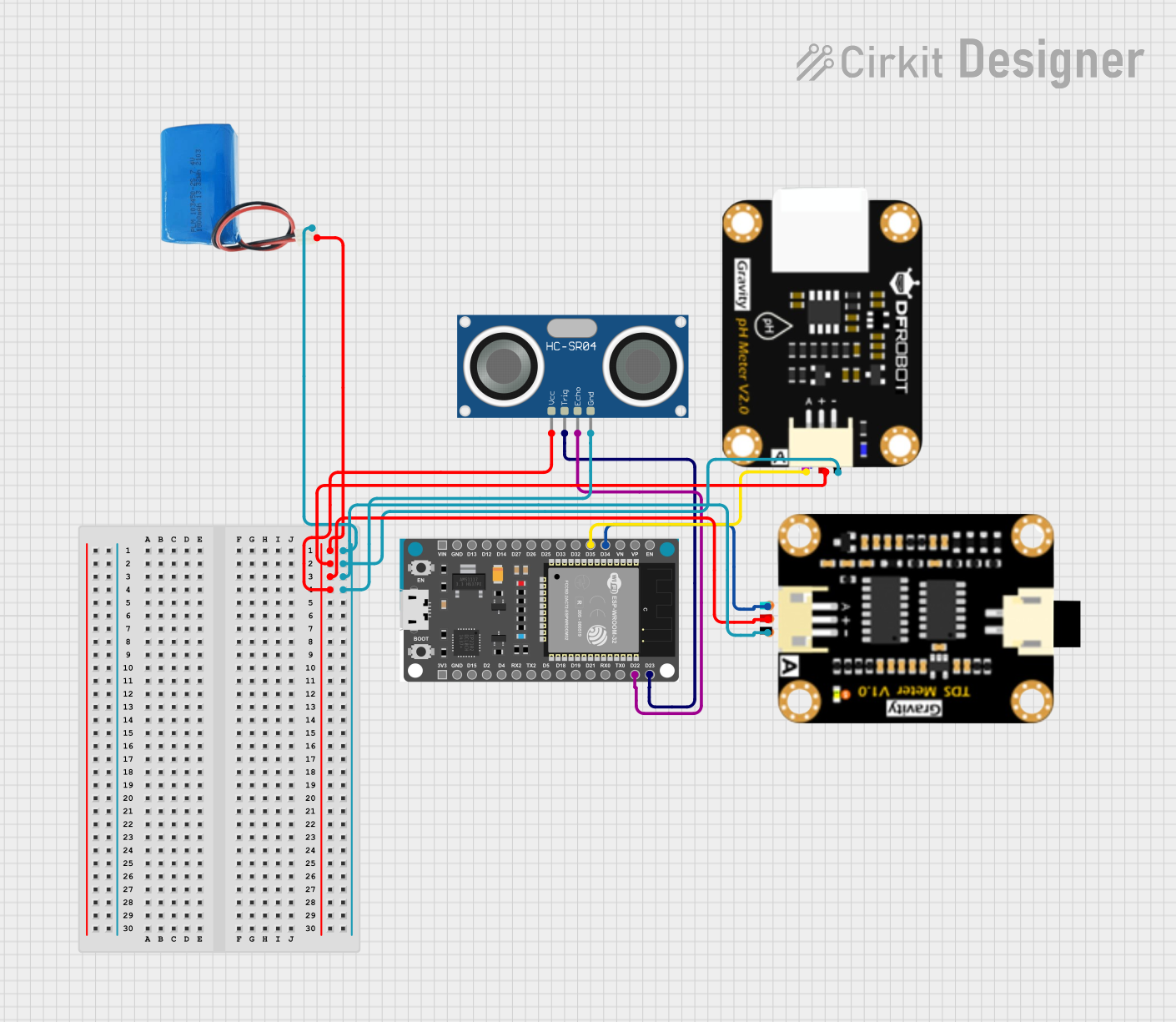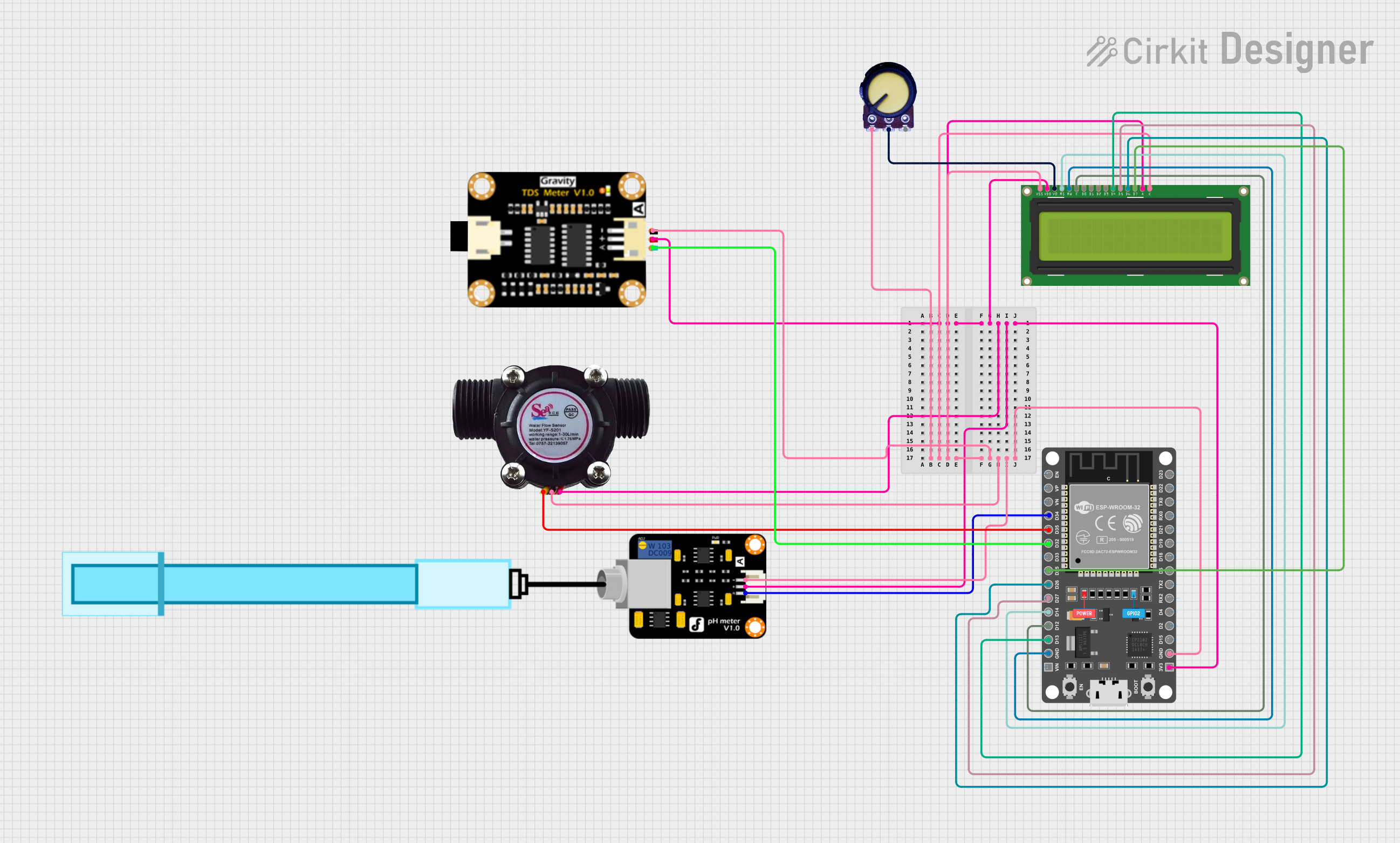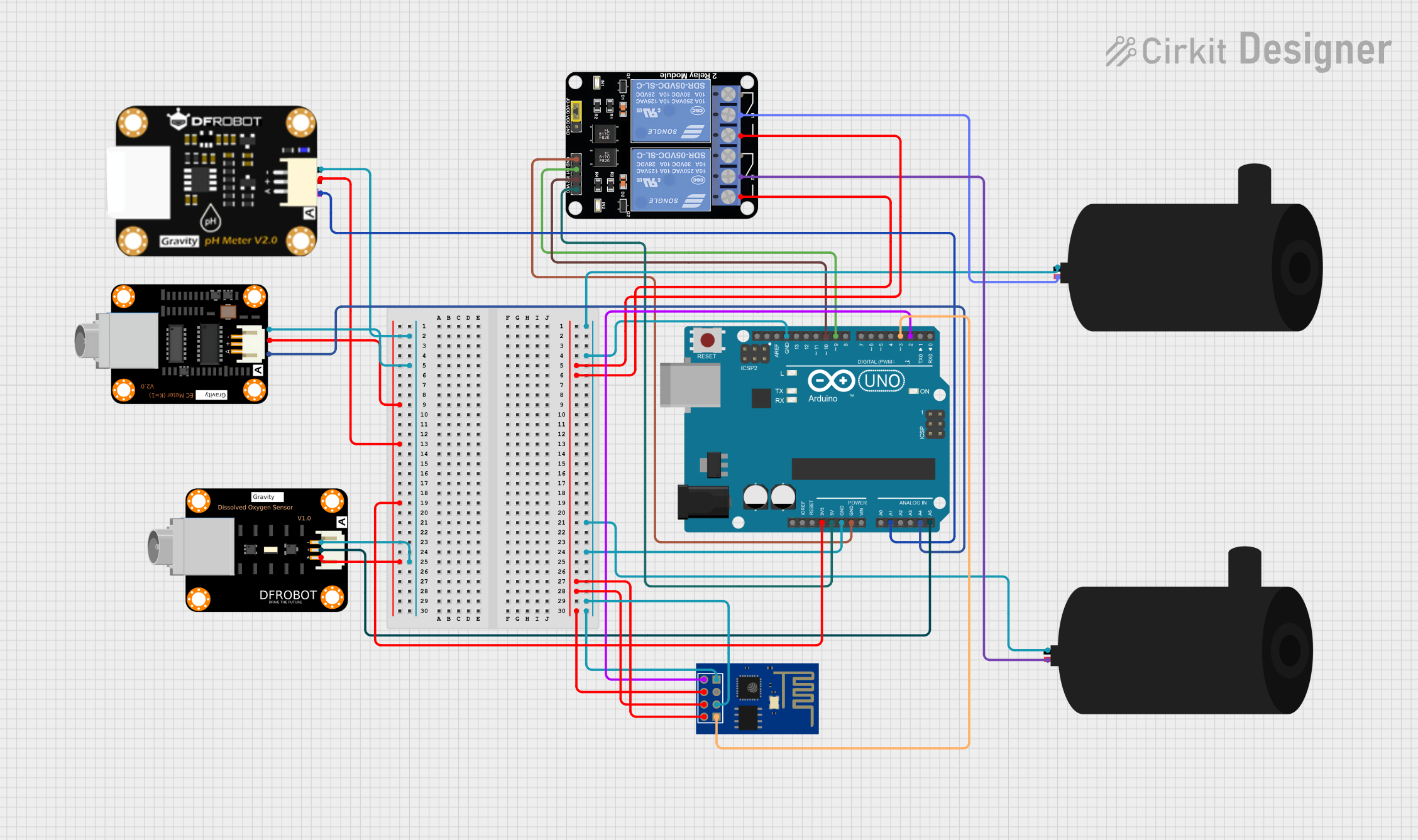
How to Use ph sensor with module: Examples, Pinouts, and Specs

 Design with ph sensor with module in Cirkit Designer
Design with ph sensor with module in Cirkit DesignerIntroduction
A pH sensor with module is an electronic device used to measure the acidity or alkalinity of a solution. It typically consists of two main components:
- pH Probe: A glass electrode that measures the hydrogen ion concentration in a solution.
- Signal Conditioning Module: Converts the analog signal from the pH probe into a digital or amplified analog signal, making it easier to interface with microcontrollers or other devices.
Explore Projects Built with ph sensor with module

 Open Project in Cirkit Designer
Open Project in Cirkit Designer
 Open Project in Cirkit Designer
Open Project in Cirkit Designer
 Open Project in Cirkit Designer
Open Project in Cirkit Designer
 Open Project in Cirkit Designer
Open Project in Cirkit DesignerExplore Projects Built with ph sensor with module

 Open Project in Cirkit Designer
Open Project in Cirkit Designer
 Open Project in Cirkit Designer
Open Project in Cirkit Designer
 Open Project in Cirkit Designer
Open Project in Cirkit Designer
 Open Project in Cirkit Designer
Open Project in Cirkit DesignerCommon Applications and Use Cases
- Water quality monitoring in aquariums, pools, and laboratories.
- Agricultural applications, such as soil pH measurement.
- Industrial processes, including chemical manufacturing and wastewater treatment.
- Food and beverage production for quality control.
Technical Specifications
Key Technical Details
| Parameter | Value |
|---|---|
| Operating Voltage | 3.3V - 5V DC |
| Output Signal | Analog (0-5V) |
| pH Measurement Range | 0 - 14 pH |
| Accuracy | ±0.1 pH (at 25°C) |
| Temperature Compensation | No (requires external compensation if needed) |
| Probe Material | Glass electrode |
| Module Dimensions | ~42mm x 32mm x 8mm |
| Operating Temperature | 0°C - 60°C |
Pin Configuration and Descriptions
Signal Conditioning Module
| Pin | Name | Description |
|---|---|---|
| 1 | VCC | Power supply input (3.3V - 5V DC) |
| 2 | GND | Ground connection |
| 3 | AO | Analog output signal (proportional to pH value) |
pH Probe
| Connector | Description |
|---|---|
| BNC Connector | Connects the pH probe to the signal conditioning module |
Usage Instructions
How to Use the Component in a Circuit
Connect the Module to a Microcontroller:
- Connect the
VCCpin of the module to the 5V pin of your microcontroller. - Connect the
GNDpin of the module to the ground (GND) of your microcontroller. - Connect the
AOpin of the module to an analog input pin (e.g., A0 on an Arduino UNO).
- Connect the
Attach the pH Probe:
- Securely connect the pH probe to the module using the BNC connector.
Calibrate the Sensor:
- Use standard buffer solutions (e.g., pH 4.0, pH 7.0, and pH 10.0) to calibrate the sensor for accurate readings.
- Adjust the potentiometer on the module to fine-tune the output signal during calibration.
Place the Probe in the Solution:
- Immerse the glass tip of the pH probe into the solution to be measured.
- Ensure the probe is rinsed with distilled water before and after each measurement to avoid contamination.
Important Considerations and Best Practices
- Calibration: Regularly calibrate the sensor to maintain accuracy, especially if used frequently or in different solutions.
- Temperature Compensation: The module does not include automatic temperature compensation. For precise measurements, use a temperature sensor to account for temperature variations.
- Probe Maintenance: Store the pH probe in a storage solution when not in use to prevent it from drying out.
- Avoid Damage: Do not expose the probe to extreme temperatures or strong acids/bases beyond its specified range.
Example Code for Arduino UNO
// Example code to read pH sensor values using Arduino UNO
// Connect the AO pin of the pH sensor module to A0 on the Arduino UNO
const int pH_pin = A0; // Analog pin connected to the pH sensor module
float voltage; // Variable to store the sensor's output voltage
float pH_value; // Variable to store the calculated pH value
void setup() {
Serial.begin(9600); // Initialize serial communication at 9600 baud
pinMode(pH_pin, INPUT); // Set the pH pin as input
}
void loop() {
// Read the analog voltage from the pH sensor
voltage = analogRead(pH_pin) * (5.0 / 1023.0);
// Convert the voltage to pH value (example formula, adjust as needed)
pH_value = 3.5 * voltage + 0.0; // Adjust slope and offset based on calibration
// Print the pH value to the Serial Monitor
Serial.print("pH Value: ");
Serial.println(pH_value);
delay(1000); // Wait for 1 second before the next reading
}
Troubleshooting and FAQs
Common Issues and Solutions
| Issue | Possible Cause | Solution |
|---|---|---|
| pH readings are unstable or fluctuate | Probe not properly calibrated | Calibrate the sensor using standard buffer solutions. |
| No output signal from the module | Loose connections or incorrect wiring | Check all connections and ensure proper wiring. |
| pH readings are consistently inaccurate | Probe is dirty or damaged | Clean the probe with distilled water or replace it if damaged. |
| Output signal is not proportional to pH | Incorrect formula in code | Adjust the formula based on calibration results. |
| Probe dries out when not in use | Improper storage of the probe | Store the probe in a proper storage solution. |
FAQs
Can I use the pH sensor in high-temperature solutions?
No, the pH probe is designed for use in solutions with temperatures between 0°C and 60°C. Exceeding this range may damage the probe.How often should I calibrate the pH sensor?
Calibration frequency depends on usage. For critical applications, calibrate before each use. For general use, calibrate weekly or monthly.Can I use the pH sensor with a 3.3V microcontroller?
Yes, the module supports an operating voltage of 3.3V. Ensure the microcontroller's analog input can read the output signal range.What should I do if the probe gets clogged?
Soak the probe in a cleaning solution recommended by the manufacturer to remove clogs or deposits.
By following this documentation, you can effectively use and maintain your pH sensor with module for accurate and reliable pH measurements.